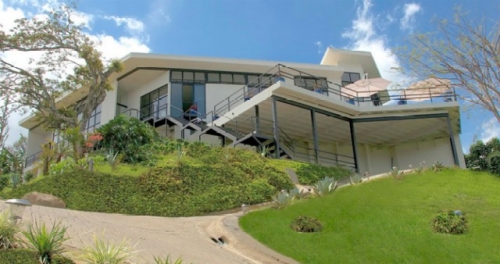Costa Rica Guide
Costa Rica Real Estate
List your property today!
Inclusion of real estate listings at Costa Rica Guide is
absolutely free of charge.
Featured Properties
Costa Rica Guide - Costa Rica Real Estate
People - Costa Rica Country Profile
Over and over again, people talk about the spontaneous hospitality of Costa Rican people that made their stay extra special.
To "Ticos", a smiling face and a helping hand to friends, both old and new, are almost their manner of speech and everyone greets each other, even in passing. Visitors quickly discover that "Ticos" take immense pride in their cultured, democratic society with its excellent educational and health care systems. A Costa Rican’s aspirations are limited only by his industry, imagination and ingenuity.
Cooperative efforts are an integral part of the Costa Rican culture, yet the strength and dignity of the individual is highly valued. Family is still very important to "Ticos". Another fact which keeps the country strong and on an even keel.
Democracy, decision by consensus and non-military solutions are a way of life - from government right on down.
Somewhat unique, in what has been an otherwise politically and socially turbulent part of the world, Costa Rica’s history holds the keys to the "Tico" national character.
The Costa Rican penchant for taking the best of outside influences and adapting goes back to pre-European contact. Cultural influences and material from both continents are reflected in archeological findings. No jade deposits have been found in Costa Rica. Metallurgy techniques probably came from the south. Yet many artifacts exist in jade, gold, pottery and other materials, their designs uniquely Costa Rican. Exquisite example of the high level of craftsmanship that was attained here can admired at any of three downtown museums housing Pre-Columbian exhibits: the National Museum, and the Jade Museum.
The "Tico" spirit of cooperation also developed early. Between 300,000 and 500,000 people were living in Costa Rica when Columbus landed on the Atlantic coast in 1502. Contrary to popular myth, the coastal tribes put up quite a battle. Between their resistance, the impenetrable jungle and the apparent lack of treasure for plunder, the Spaniards didn’t give Costa Rica high priority. Eventually, colonizers came through what is now Guanacaste to the Central Valley. The only way for colonist t survive in this tiny, poor cousin colony was to live off the land.
They built native -style homes, made native-style clothes and learned the meaning of cooperation and tolerance.
Yet, they were strongly individualistic.
This was the origin of Costa Rica’s firmly entrenched concept of solidarity- groups working together, in cooperation with employers, for the well-being of the individual.
The fact that Costa Rica is non-aggressive country no military also has its roots in history. Costa Rica learned of its independence only after the fact, when, on October 17, 1821, a rider from Nicaragua brought the news. The country subsequently joined the new Central American Federation. Perhaps because the first governor was a teacher, not a soldier, Costa Rica didn’t suffer the civil wars that plagued other countries in the federation countries of that era. Costa Ricans were too busy building schools and making paper by hand.
Costa Rica is one of oldest democracies in the Americas, its first election held in 1889. The few times tyranny tried to gain the upper hand it quickly failed. In 1949, the modern constitution abolished the army and directed the country’s resources to education, social programs and economic development. Two generations have grown up without knowing war. This political stability has attracted many international organizations to Costa Rica, such as the Interamerican Court of Human Rights, the International Development Bank and the Earth Council.
Costa Rica’s first university was established in 1843 although, in the early years, many of the coffee barons still preferred to send their children to Europe. They brought back European ideas and a taste for fine art and music that continues to this day.
In fact, the construction of the National Theater, the country’s premier architectural showpiece which was completed in 1897, was financed largely through export tax on coffee.
Free, compulsory education was establish in 1917.
Today children must attend school until the end of the 9th grade, after which many scholarships and grants are available for continuing education.
Respect for the dignity of all human beings is a Costa Rican reality. Slavery was abolished in 1823, the last execution held 1859 and capital punishment officially abolished in 1883. Women won the right to vote in 1949. Perhaps Costa Rica’s racial tolerance comes from being a very heterogeneous population; a mix of southern European, Asian, African and Indian American ancestry.
Historically an agricultural based economy, people maintain close ties with the land owning even a small parcel is traditional.
Although rural in spirit, "Costa Ricans" embrace high tech (just notice the number of cellular phones) and constantly look to the future. San José was the third city in the third city in word to have electric lights! /p>
In the more consumer oriented Central Valley, Costa Ricans seem pretty much like North Americans. But strong traditions have forged a distinct national personality. On your vacation, be sure to make a "Tico" friend.
Costa Ricans love to eat! First time visitors are always amazed at the proliferation of restaurants. Discovering the scope and sophistication of the culinary arts will probably be one of the most delicious surprises of your Costa Rican vacation.
With farming conditions that range from hot humid lowlands, to cool mountain slopes, Costa Rica produces the full range of temperate and tropical foodstuffs. Everything from shrimp to brook trout avocados to asparagus. Add a cosmopolitan society, whose citizens trace their heritage to dozens of European and Asian countries, and Costa Rica is a natural, culinary melting pot.
Be sure not to miss Costa Rica’s own
"Tico" fare is neither spicy nor, in many respects, unfamiliar. It is built around the basic of rice, beans, corn, vegetables, meat, chicken or fish and usually served corn tortillas.
Breakfast typically features a delicious mixture of rice and black beans know as "gallo pinto" which may be accompanied by eggs, corn tortillas and sour cream.
Calorie counters may prefer a tropical fruit plate of papaya, watermelon, pineapple, banana and, in season, mango or cantaloupe.
Casados, popular at mid-day, are huge plates of white rice, beans, fried plantain, salad cheese, diced vegetables, and your choice of meat, chicken or fish. Hearty soups are a favorite for dinner.
Commonly served desserts include caramel or coconut flan, several types of pudding, and a cake called "tres leches". The fresh fruit drinks, "refrescos naturales", are flavorful and healthy. Any kind of fruit, from strawberries to mango, is mixed in a blender with crushed ice, either water or milk and a little honey or sugar.
"Comida típica" is much more varied than you’ll find in most restaurants. Many dishes are associated with special holidays.
In December, the whole family helps make the Christmas "tamales", one of the most traditional dishes.
Visitors to Limón discover a distinctly Caribbean flavor and many recipes based on coconut milk. Those with a sweet tooth won’t want to miss "panbón", a heavy fruit bread redolent with spices.
Guanacaste offers its own distinctive dishes with corn being a staple ingredient. Huge tortillas with melted cheese are delicious.
Costa Rica produces some of the finest coffee in the word. Beans fore local consumption are often roasted with sugar to make a thick, dark coffee that is not at all bitter. Traditionally, this strong coffee was served half and half with milk, in a tall glass. After tasting it, you won’t want to go home several bags of beans.
Every March, ox-cart owners from all over Costa Rica converge on the of Escazú to complete for honors in Annual Ox-cart Festival. Draw by majestic teams of Cebu oxen, the brightly-colored carts are painted in fanciful decorations that have characterized the Costa Rican working ox-cart for more than a hundred years. Souvenirs shops sell replicas of the carts and wheels in every possible size. It would be hard to find a more representative souvenir of our culture. Painted in bright, primary colors, ox-carts are definitely tropical, their exuberant designs a reflection of Costa Rica’s agricultural bounty and the spirit with which our farmers work the land.
Flower motifs symbolize a peaceful way of life and the sensitive nature of a people who would honor an ordinary work tool with such artistry.
The ox-cart is still used, occasionally, but low-tech farming has largely been replaced by modern methods and machinery. Indeed, Costa Rica is a word center for research and practical application methods in the tropics.
The School for Agriculture in the Tropical Humid Region (EARTH), the Center for Research and education in Tropical Agronomy (CATIE) and the Central American School of Animal Husbandry (ECAG) are among the institutions works towards greater long-term productivity on less land environmental impact. All are open to tourism and definitely worth the visit.
In modern Costa Rican agriculture, computers do everything from determining soil viability, to making crop projections and keeping track of the payroll. Many of our farmers are scientists who drive late-model, 4-wheel-drive vehicles and run their businesses with a cellular phone.
Their children learn computer skills in elementary school -tomorrow’s high tech farmers.
If modern technology has influenced the agricultural sector, it is all pervasive in the rest of the country. And not just in the Central Valley.
Visitors are surprised to find computers and a fax machine at their jungle lodge and, even in the remotest areas, a solar- powered telephone.
In fact, there is almost nowhere in Costa Rica where you are cut from instant international telephone communication.
Seemingly miles from nowhere, there’s usually at least a "public phone". From any phone, a three-digit number will put you in touch with an operator back home. At many of the bigger hotels and business centers you can send a message by e-mail.






